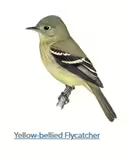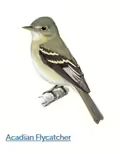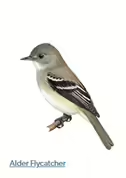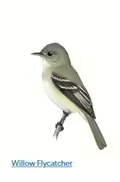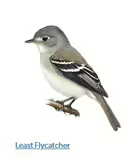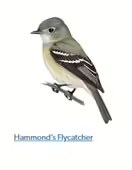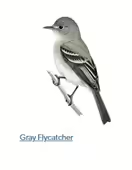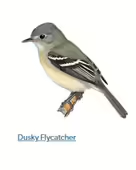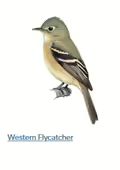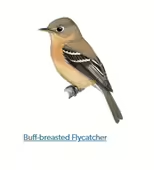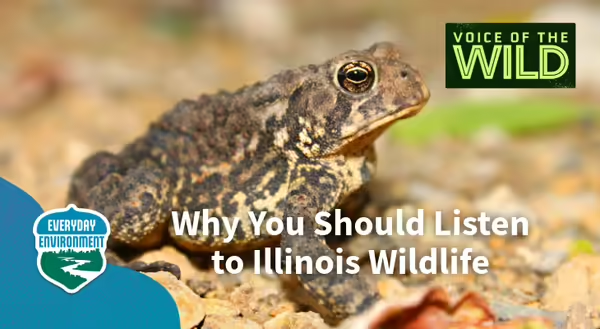
In late May, I toured an urban central Illinois woodland alongside my colleagues. Many of them have birding experience and noted birds as they appeared along the trail. We saw a red-tailed hawk, European starling, brown thrasher, northern cardinal, American robin, and house finch.
Something I often say when I’m talking about the Voice of the Wild podcast is –
If you learn to listen for wildlife, you will find it everywhere.
Many animals are hidden from us – they may be literally hiding beneath a woodpile, concealed behind foliage, or resting invisibly against a tree trunk with which they share a pattern and color.
Listen to reveal nature's hidden singers
That late in spring when we were touring the woodland, line-of-sight is a major limitation when birding. Luckily, we were also listening. I pointed out the call of a northern parula; it was probably on-territory, calling high in the canopy to attract a mate. Closer to the ground, there were northern house wrens proudly issuing their complex, jumbled songs. Someone noted a Carolina wren loudly singing across the road. A handful of singers serenaded us the entire trip: red-eyed vireos, American goldfinch, a gray catbird, and, in a weedy forest clearing, a few common yellowthroats. An entire orchestra of animals were singing just out of sight.
If we had only counted the birds we could see, the list would have stopped at six species. Using our ears, we found many more.
Find rarities
Wildlife may also be figuratively hidden; secreted away not by occlusion, but by our own inattention. Just think – do you hear the air conditioner every time it kicks on? Do you hear every conversation in a coffee shop?
Our minds are very good at filtering out the audible chaos of everyday life. While most of my colleagues had heard the previous birds, only a handful noted the flock of warblers that flew into the trees above our lecture on butternut hickories. It was mostly American redstarts, but with at least one chestnut-sided and Tennessee warbler mixed in. A few of us craned our necks to admire the colorful birds above us, alerted to their presence only by a few gentle-sung calls and a handful of chips. It was a delight we were able to enjoy only because we knew to listen.
Easy song identification
There are a handful of creatures for which learning their call is an outright necessity for identification. The day-singing cicadas each have unique songs but appear nearly identical, and the same can be said for several amphibians.
The best example of this phenomenon is the Empidonax Flycatchers. There are 10 of them, five of which can be found regularly in Illinois. Each of these flycatchers has greyish plumage, an eye ring, and dark wings with light wing bars. Given the variation present within each species, telling them apart can be exceedingly difficult. Habitat can give you hints, but it is not perfectly reliable. While their appearance is all but identical, their songs are very distinct – the Acadian flycatcher even sounds like a dog’s squeaky toy. In this way, learning the calls of the Empids is essential to their identification.
Great for Sharing
Sound is a great way to share nature with your friends and family. The distance it affords from the animal bypasses a lot of common problems – be it mobility (appreciating it does not usually require slogging through the mud) or traditional hangups about animals perceived as “gross” (they don’t even have to look at the frogs, much less touch them!)
Sharing these sounds can also enrich people’s lives. Most animals that sing are doing so in the warm months – the same ones in which we’re having bonfires, cookouts, house parties, and meeting our friends at restaurants to eat out on the patio. There’s a beautiful cast of background characters at all those events, from the chimney swifts chattering overhead to the common true katydids grinding out calls in nearby trees. Getting an introduction to those characters can be a real delight, or at least a good conversation starter.
Where can you learn more
A great place to start is Illinois Extension’s wildlife sound identification podcast, Voice of the Wild. Each episode features a new wild singer. I post weekly and have been running the show for a little over a year now, so there's a good backlog of episodes. I tried to cover a lot of the most common singers in the first year, so I promise you’ll pick up some useful information if you try a few episodes
If you’re looking to learn birds while you’re out and about, try Cornell’s Merlin bird app. It has a sound identification feature, which is OK, but don’t rely on it to accurately identify rare birds and don’t post observations to eBird that you aren’t 100% sure you’ve heard yourself.
You can also record sounds on your phone and post them to iNaturalist, though you’ll often need to know roughly what an animal is – bird, insect, or frog – for someone to chime in with an identification.
If you want to delve even deeper into the world of wildlife sound identification, these are some of the resources I used when learning to recognize wildlife calls. Fair warning, most of these require a way to play an ancient media format called “Compact Disc.”
- Guide to Night-Singing Insects of the Northeast by John Himmelman and Michael DiGiorgio
- Birding by Ear: Eastern/Central by Richard K. Walton and Robert W. Lawson
- More Birding by Ear: Eastern/Central by Richard K. Walton, Robert W. Lawson, and Roger Tory Peterson
- Bird Song Ear Training Guide: Who Cooks for Sam Peabody? Learn to Recognize the Songs of Birds from the Midwest and Northeast States by John Feith
- A Field Guide to Bird Songs: Eastern and Central North America by the Cornell Lab of Ornithology
About Everyday Environment
Everyday Environment is a series of blogs, podcasts, webinars, and videos exploring the intricate web of connections that tie us to the natural world. Want to listen to us chat about this topic? Check out the podcast episode on this topic to hear more from the Everyday Environment team about wildlife resources.
Was there something about this blog's topic we didn’t cover? See something cool in nature? Let us know! Send us your question or share your everyday nature observation with us at go.illinois.edu/EEconnect, and we may share it in a future blog or podcast.
Listen to the Podcast Get the Everyday Environment Newsletter Connect with Us
